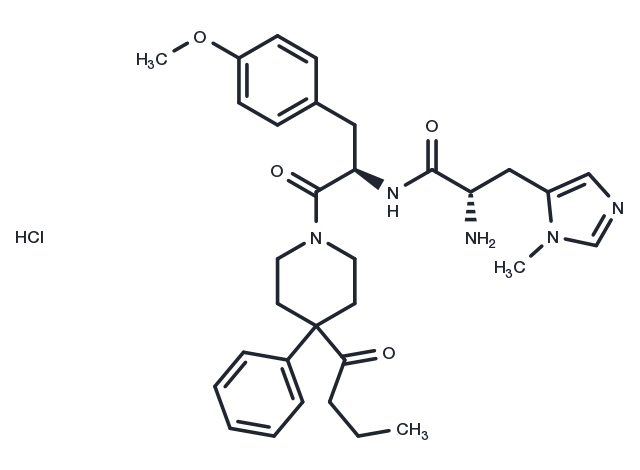Powder: -20°C for 3 years | In solvent: -80°C for 1 year


BMS-470539 dihydrochloride is a highly potent and selective agonist of the melanocortin-1 receptor (MC-1R; IC50: 120 nM; EC50: 28 nM) with anti-inflammatory properties. It does not activate MC-3R and is a very weak partial agonist at MC-4R and MC-5R.

| Pack Size | Availability | Price/USD | Quantity |
|---|---|---|---|
| 2 mg | 5 days | $ 108.00 | |
| 25 mg | 6-8 weeks | $ 734.00 | |
| 50 mg | 6-8 weeks | $ 954.00 | |
| 100 mg | 6-8 weeks | $ 1,740.00 |
| Description | BMS-470539 dihydrochloride is a highly potent and selective agonist of the melanocortin-1 receptor (MC-1R; IC50: 120 nM; EC50: 28 nM) with anti-inflammatory properties. It does not activate MC-3R and is a very weak partial agonist at MC-4R and MC-5R. |
| Targets&IC50 | MC1R:120 nM, MC1R:28 nM (EC50) |
| In vitro | An established HBL melanoma cell line stably expresses an NF-κB luciferase reporter, allowing for the observation that TNF-α at 0.5 ng/mL incites a dose-dependent escalations in NF-κB luciferase activity. Administering BMS-470539 to these HBL-NF-κB cells leads to a dose-dependent diminution in TNF-α-induced NF-κB luciferase activity, while it remains ineffective in altering luciferase reporter activity in the absence of TNF-α induction. In nontransfected HBL cells, BMS-470539 administration shows a dose-dependent deterrence of NF-κB nuclear translocation. |
| In vivo | The treatment of BMS-470539 (2.05-18.47 mg/kg; i.v.; for 125 minutes; WT and MC1 receptor recessive e/e mice) inhibits cell emigration and adhesion with no effect on cell rolling. It also inhibits the tissue expression of CXCL1/CCL2 [3]. |
| Molecular Weight | 596.17 |
| Formula | C32H42ClN5O4 |
| CAS No. | 2341796-82-3 |
Powder: -20°C for 3 years | In solvent: -80°C for 1 year
You can also refer to dose conversion for different animals. More
bottom
Please see Inhibitor Handling Instructions for more frequently ask questions. Topics include: how to prepare stock solutions, how to store products, and cautions on cell-based assays & animal experiments, etc.
BMS-470539 dihydrochloride 2341796-82-3 Others BMS 470539 BMS470539 Dihydrochloride BMS470539 dihydrochloride BMS 470539 Dihydrochloride BMS-470539 BMS470539 BMS 470539 dihydrochloride BMS-470539 Dihydrochloride inhibitor inhibit
